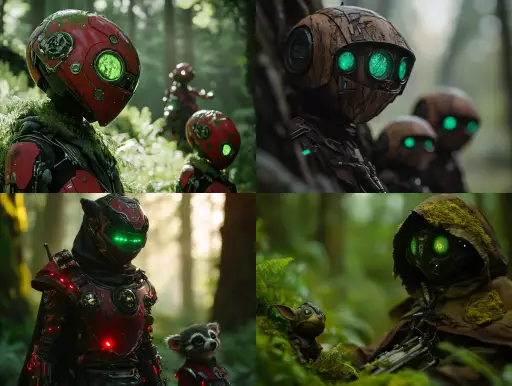Explore the Best AI Image Gallery

Pixelated Perceptions: How AI-Generated Visual Content is Reshaping the Creative Landscape
The realm of art and design has always been a playground for innovation, constantly evolving with new tools and technologies. Today, we stand at the cusp of another revolution: the rise of AI-generated visual content. This transformative technology, capable of producing stunning imagery, videos, and even 3D models, is poised to reshape the creative landscape in profound ways.
A New Creative Frontier
AI algorithms, trained on massive datasets of existing artwork and design elements, can now generate original visuals that are often indistinguishable from human-created content. This opens up a world of possibilities for artists, designers, and businesses alike:
- Democratization of Creativity: AI tools can empower individuals with limited artistic skills to create compelling visual content, fostering greater accessibility and inclusivity in the creative process.
- Enhanced Efficiency and Productivity: Artists and designers can leverage AI to automate repetitive tasks, such as generating variations of a design or creating backgrounds, freeing up valuable time for more conceptual work.
- Exploration of New Artistic Styles: AI algorithms can experiment with novel aesthetics and artistic styles, pushing the boundaries of creative expression and inspiring fresh perspectives.
Beyond Aesthetics: Practical Applications
The applications of AI-generated visual content extend far beyond simply creating aesthetically pleasing images. Its already making waves in various industries:
- Marketing and Advertising: Generating personalized visuals for targeted campaigns, creating dynamic ad creatives, and designing eye-catching social media content.
- Gaming and Entertainment: Developing realistic game environments, creating unique character designs, and generating procedural content for immersive experiences.
- Education and Research: Visualizing complex data sets, creating interactive learning materials, and aiding in scientific research by generating simulations and models.
Navigating the Ethical Landscape
As with any powerful technology, AI-generated visual content raises important ethical considerations:
- Copyright and Ownership: Who owns the rights to AI-generated artwork? How do we address issues of plagiarism and intellectual property when algorithms are involved?
- Bias and Representation: AI algorithms can perpetuate existing societal biases if trained on biased data. Its crucial to ensure that AI-generated content is inclusive and representative of diverse perspectives.
- Transparency and Accountability: The decision-making processes of AI algorithms can be opaque. Its essential to develop transparent methods for understanding how AI generates content and to establish clear lines of accountability.
Future Visions: The Evolving Canvas
The future of AI-generated visual content is brimming with possibilities. We can expect:
- More sophisticated and realistic outputs: Continued advancements in AI algorithms will lead to even more lifelike and convincing visuals.
- Increased user control and customization: Tools will empower users to fine-tune AI-generated content, allowing for greater creative input and personalization.
- Integration with other technologies: AI-generated visuals will seamlessly integrate with virtual reality, augmented reality, and the metaverse, creating immersive and interactive experiences.
The rise of AI-generated visual content is a transformative force in the creative industry. It presents both exciting opportunities and complex challenges. By embracing its potential while navigating its ethical implications responsibly, we can unlock a new era of artistic expression and innovation.










](https://images.ai-img.art/thumbnails/150/4289d1230b86a96c4d556636c3167bed0ef38f850826549517e4e45db4d87bf7.webp)


](https://images.ai-img.art/thumbnails/150/c2c9c48b38fae37f0a457b80b084ed01ba803810fc8f488c8f610c03abc74049.webp)







](https://images.ai-img.art/thumbnails/150/f9584153b4cddd8c9fab611dc10247549b275c59bc173251e37d0935874f9deb.webp)






](https://images.ai-img.art/thumbnails/150/bddf3ae4a232290858389b933c866ad3be429ef2e25c23a9f4d7713ed6e44d0b.webp)






](https://images.ai-img.art/thumbnails/150/f67d9af3398150f2ab1bcf250717fea134275e2ca896252b54a4d9bb3719f9ac.webp)
](https://images.ai-img.art/thumbnails/150/008b5d5d49667cc2e93a5f8a8adfaa545963da99c39ff0901f5296294636400d.webp)




